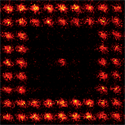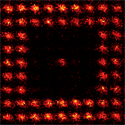Addressing the crowd
Apart from their intrinsic interest as Bose-Einstein condensates, ultracold atomic gases are ripe for applications in quantum information processing and as a medium for simulating phenomena in condensed matter physics. Gathering a suitable collection of cold atoms is only half the battle, however; the atoms have to be arranged in a specific pattern and researchers must be able to manipulate individual atoms at will. Peter Würtz, Tim Langen, Tatjana Gericke, Andreas Koglbauer, and Herwig Ott at Johannes Gutenberg University in Mainz and the University of Kaiserslautern, Germany, report in Physical Review Letters their success at addressing single sites in a two-dimensional lattice of rubidium atoms.
The research team created the ultracold atomic lattice by cooling the rubidium in an optical trap, then loading the cold atoms into a two-dimensional array of potential wells formed by criss-crossing laser beams. The interference pattern of the 2D beams creates a regular pattern of atom bunches, much like eggs in a carton, but with a - lattice spacing.
To view the lattice, the researchers sweep the atomic egg-carton with the - -diameter beam from a scanning electron microscope, which ionizes the atoms and this ionization is detected and imaged by a charge detector array. By letting the beam linger on a particular lattice site, they can knock atoms out of the lattice, and by scanning over many lattice sites they can create any desired 2D pattern. Setting up patterns by removing atoms from specific sites allows the team to watch in situ tunneling processes and microengineer novel atomic interactions. – David Voss





